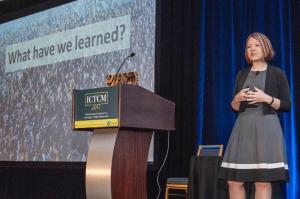Five questions for Maria Andersen
The past five years have seen a rise in large-scale, digital learning experiments – centralized courses, vendor-created courseware, online homework systems, MOOCs and free-range learning platforms. By examining the research, successes and failures emerging from these experiments, what is learned about designing better digital learning experiences and technology for learning?
That’s a question that Maria Andersen, Ph.D., will take on in “Learning at Scale: Using Research to Improve Learning Practices and Technology for Teaching,” her keynote address at next month’s COLTT (Colorado Learning and Teaching with Technology) Conference. This year’s edition is set for Aug. 9-10 at CU Boulder’s Wolf Law Building.
Andersen is a Salt Lake City-based consultant who has spent 14 years teaching at the college level, 16 years writing curriculum and six years developing digital products for learning. She built iPad games to teach algebra, launched the Canvas Network MOOC platform, built adaptive learning platforms used by McGraw-Hill and worked as director of learning design for WGU, a fully online CBE (competency-based education) institution.
While a professor at Muskegon Community College in Michigan, she directed the weeklong MCC Math and Technology workshop for five years, helping faculty to prepare to teach online or improve their skills. Andersen is a software developer and CEO of a startup, author, speaker and a learning futurist. She holds degrees in math, chemistry, biology, business administration and higher education leadership.
1. What are the key changes you see in the role of the university instructor in the last 20 years?
The role of a university instructor used to be delivering knowledge and skills required for a course or degree program and then validating the receipt of this information through a variety of assessments. While instructors still perform these two functions, we now recognize that the learning design has a much greater impact on successful uptake than previously thought. However, few professors in higher education have been trained to pay attention to learning design. We teach how we were taught.
Professors can get smarter about improving the delivery of the learning through partnerships with instructional designers and learning researchers. We need to be teaching transferable skills, because education designed for fact-based curriculum is going to become quickly obsolete.
There is no longer a single source of authoritative content. Today’s instructor, with access to a world’s worth of resources on the internet, is more of a curator, tour guide and experience creator in their subject area. They should be designing deep conceptual and goal-driven learning experiences and letting software deliver on the task of building up a fact base.
2. If you could share one transferable lesson from learning-at-scale data to all learning environments, what would it be?
One strong lesson we see from Massive Open Online Courses (MOOCs) is that many students drop out following a completely successful run at the course, usually due to falling behind. A student will persist with on-time work and engagement for several weeks and then drop the course.
When the student falls behind in an online course they have two major obstacles to overcome: 1. Getting their life back together from whatever caused the course disruption; 2. The missed content to catch up on. This combination of circumstances appears to be insurmountable in course after course. The lesson learned, for the digital learner in particular, is the need for better strategies to help students “slip” into an alternate set of deadlines and interactions with other students.
3. How does your recent career history shape your perspective on technology for teaching?
At this point, I have been on many “sides” of educational technology: I’ve been a student user, an instructor user, an administrative user, a technology adoption decision maker, a product manager for edtech software, and now the cofounder of an edtech software company. I think having these multiple perspectives on educational technology is unusual in the industry – this makes me more likely to empathize with the end user – whether it be student or instructor – and advocate for usable, practical and delightful-to-use software.
4. What is the value of engaging students in their learning community online or otherwise?
Interaction is a highly valuable tool in our learning design toolkits. Students learn more by interacting, whether it be with content (through knowledge retrieval assessments) or with other students (explaining or asking questions). If we want concepts from one course to transfer to solving novel problems in other subject areas, students must have a chance to explore what they do or do not know – and that comes through interaction.
5. What can COLTT attendees expect to take away from your keynote?
Whether you teach in a traditional classroom or online, there are ways we can design learning more effectively to work with the chosen educational technology. Attendees should walk away with some new ideas for improving the courses they are involved in as well as feeling challenged to rethink some traditional digital practices.



